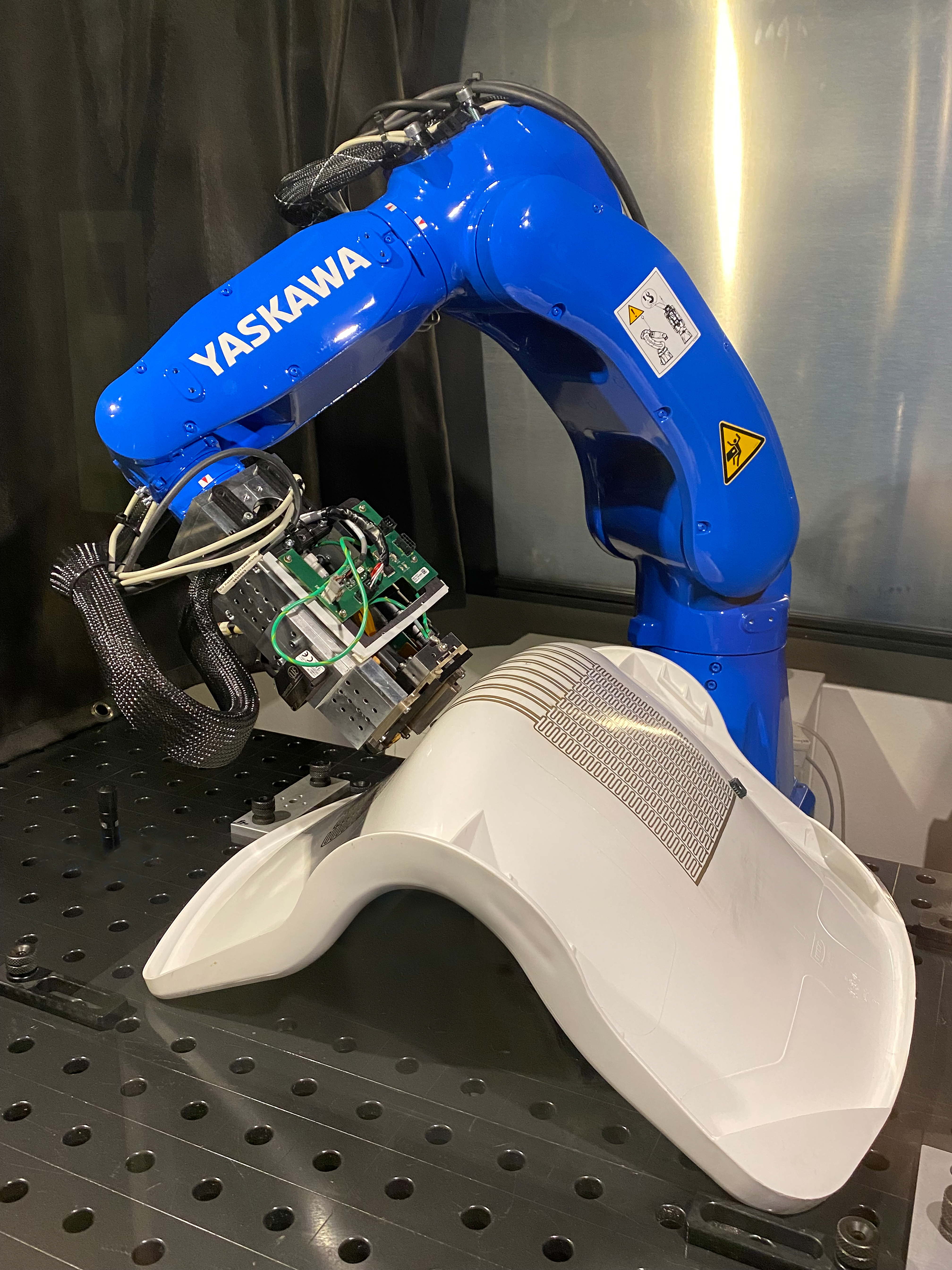InPrint Munich 2022 and LOPEC 2022
Technologies for the production of printed functionalities on 3D objects
The Fraunhofer Institute for Electronic Nano Systems ENAS is presenting various printing technologies for functionalizing 3D objects at this year‘s LOPEC in Munich. Applications range from contacting individual microchips in electronic systems to large-area heating structures for seats. At the booth, the research team will show a robot setup with an integrated print head for inkjet printing and functionalized prototypes.

The printing of functional elements onto 3D objects is a research topic of Fraunhofer ENAS in Chemnitz. The institute has a wide range of applications in mind, from the contacting of microelectronic components and functional structures such as heating elements to wiring in car doors. A wide variety of equipment is available to the researchers, including two six-axis industrial robots for large-area structures equipped with inkjet printing heads, as well as aerosol jet printers and a cluster system for 3D electronic systems. Further functional units, for example for pre-treatment with plasma, for post-treatment with ultraviolet and infrared light or laser, and for object recognition, complete the laboratory equipment.
Robot-guided inkjet printing for the functionalization of 3D objects
The “Printed Functionalities” team, led by Prof. Ralf Zichner, is working with partners from science and industry to develop processes and technologies for robot-guided inkjet printing. In this context, robot control is being further developed based on algorithms for path planning and control in order to print objects independently of their position and location or to enable the correct juxtaposition of several print paths despite their surface curvature. Limiting factors of the printing process are also in the focus of investigations. Spacing limits in web planning are derived based on the positioning accuracy of individual drops on cylinder surfaces, and descriptions are provided for printing concave objects, taking print head geometries and angulation into account. “Only the sum of technological knowledge in combination enables us to realize the development of a technology offer for printing processes on 3D components,” says Ralf Zichner. “This includes not only knowledge about the system design and the printing process itself, but also about pre- and post-treatment processes, ink selection and the design of electronic components.”
The knowledge gained is already being incorporated into system development at industrial partners such as Chemnitz-based C-marx GmbH. At its booth at LOPEC 2022, Fraunhofer ENAS will be demonstrating a robot setup developed in-house with an industrial inkjet print head.
Prototype development for printed seat heaters and wiring harnesses
In addition to technology development on an industrial scale, Fraunhofer researchers are focusing on applications. The use of printing technology on 3D objects is interesting for many industries. In the automotive industry, it was demonstrated that printed conductors can be used not only to replace wiring harnesses, but also to individually equip vehicle parts. Using a car door as an example, a project team in the Fraunhofer lighthouse project “Go Beyond 4.0” led by Fraunhofer ENAS demonstrated how printed as well as dispersed conductive tracks supply power to switches and loudspeakers installed in the vehicle door. As a current application example, a seat shell for stadium seats will be shown at LOPEC. The seat has been functionalized with printed heating structures and RFID components. This allows stadium visitors to enjoy sporting events, for example, even in the cold season on warm seats. At the same time, the integrated RFID transponder enables to identify occupied seats so that the heating can be activated for precisely these seat shells in an energy-saving manner.
In addition to robot-guided inkjet printing, the research institute will present application examples for the functionalization of smaller components such as housing caps of electronic systems and the integration of microchips and other electronic components by means of aerosol jet printing and a cluster system for the production of 3D electronic systems at LOPEC 2022. Fraunhofer ENAS will present the research topics at booth B0-FO11 from March 23-24, 2022 in Munich.
In cooperation with C-marx GmbH, the robot-guided inkjet printing technology and the prototype of a printed seat heater will already be shown at the booth of SEIKO Instruments GmbH, booth 2764 at InPrint Munich from March 15 to 17, 2022.
Last modified:
 Fraunhofer Institute for Electronic Nano Systems
Fraunhofer Institute for Electronic Nano Systems